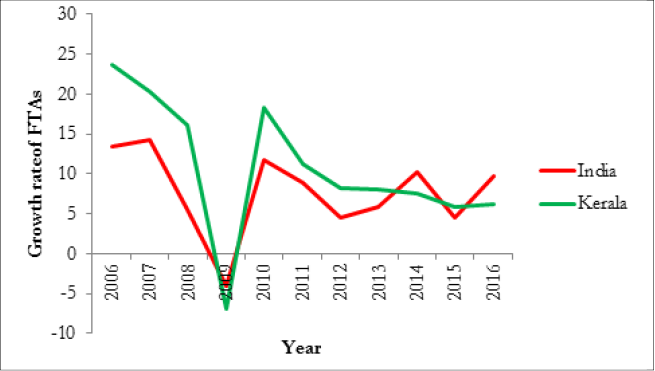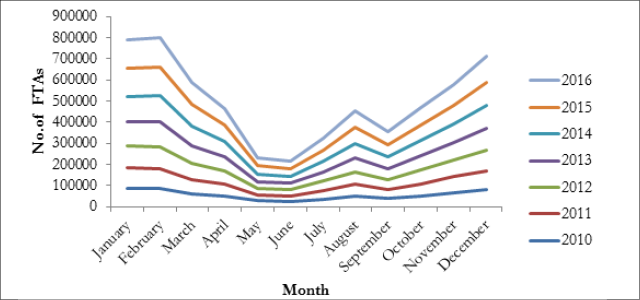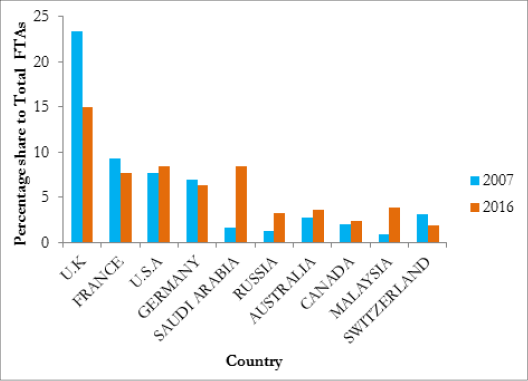International and regional tourism contributes to economic growth, job creation and development in nations all around the world. Tourism accounts for 10 per cent of global GDP, 7 per cent of total exports and one in 10 jobs across the world. In 2016, international tourist arrivals reached 1.2 billion. By 2030, 1.8 billion travellers are expected to cross international borders.
India is ranked at 40th position in the Travel and Tourism Competitive Index of World Economic Forum in 2017.
Kerala is blessed with varied geographical features that have made it one of the most sought after destinations in Asia. Tourism is the hallmark of Kerala’s economic development and a principal contributor to the State’s economy. Kerala is now recognised internationally as a tourist destination. Tourism enables balanced and sustainable regional growth by generating income and creating employment opportunities especially in trade, transport and hospitality sectors. The sector earns foreign exchange to the State and promotes traditional industries.
The share of tourism in Kerala’s Gross State Domestic Product is about 10 per cent. Tourism creates employment, brings in incomes, and opens out cultures to the rest of the country and world. A feature of tourism is its interconnection with other spheres of development. Tourism cannot be successful without concurrent development in health, sanitation, urban and rural planning, transport, connectivity, local self-government and other spheres.
International Year of Sustainable Tourism for Development
The United Nations General Assembly declared 2017 as the International Year of Sustainable Tourism for Development. It thus recognised the potential of tourism to advance the universal 2030 Agenda for Sustainable Development. This declaration was made by the UN in recognition of tourism’s contribution to the development agenda and to raise awareness of the potential of the sector to lead economic growth, social inclusion and cultural and environmental preservation.
12th Five-Year Plan Achievements
An amount of 1,101.4 crore was the budgeted outlay for the tourism sector during the 12th Five-Year Plan period and expenditure incurred was 1,046.37 crore (95 per cent). In addition to this, funds were mobilized through Supplementary Demand for Grants. Central financial assistance was also availed for destination development, fairs and events, and research oriented projects etc.
The department/agencies coming under the tourism sector are
The International Year of Sustainable Tourism for Development aims to support a change in policies, business practices and consumer behavior towards a more sustainable tourism sector than can contribute effectively to the SDGs.
The International Year will promote tourism’s role in the following five key areas:
Major Schemes Implemented During 12th Five-Year Plan
| Sl. No. | Department/Agency | 12th Five Year Plan 2012-17 | Annual Plan 2017-18 | ||
| Outlay | Expenditure | Outlay | Expenditure (as on 30/9/17) | ||
| 1 | Department of Tourism | 992.85 | 962.59 | 316.51 | 97.81 |
| 2 | Kerala Tourism Development Corporation (KTDC) | 32.00 | 19.00 | 7.20 | |
| 3 | Kerala Tourism Infrastructure Ltd (KTIL) | 11.00 | 8.91 | 1.67 | |
| 4 | Bakel Resorts Development Corporation (BRDC) | 7.00 | 3.45 | 3.00 | |
| 5 | Eco Tourism Directorate | 17.05 | 15.44 | 3.85 | |
| 6 | Kerala Institute for Tourism and Travel Studies (KITTS), Food Craft Institute (FCI) and State Institute of Hospitality Management (SIHM) | 41.50 | 36.98 | 10.50 | .5 |
| Total | 1101.40 | 1046.37 | 342.73 | 98.31 | |
| Source: Annual Plan documents, Kerala State Planning Board | |||||
Summary of Achievements of the Schemes Implemented during 12th Five-Year Plan
A. Destination Development Initiatives
B. Green Carpet Initiative for Destination Development
C. Marketing Initiatives of Kerala Tourism
D. IT Initiatives of Kerala Tourism
World Scenario
International tourist arrivals across the globe grew by 4 per cent in 2016 to reach a total of 1.2 billion in 2016. This was the seventh consecutive year of above-average growth with international arrivals increasing by 4 per cent or more every year since the post-crisis year of 2010. The year 2016 witnessed growth in international tourist arrivals of some 46 million over 2015. Growth in advanced economy destinations (+5 per cent) exceeded that of emerging economies (+2 per cent) in 2016. Asia and the Pacific are the most visited regions in the world after Europe. A major share of international tourist arrival is from France (6.7 per cent), USA and Spain (6.1 per cent). India’s contribution is 1.2 per cent. China is fast becoming the main source market for many destinations including those within Asia and Pacific. United Kingdom and United States of America are the major countries availing e-tourist visas in 2016.
In 2016, the number of foreign tourist arrivals in India was 8.80 million as compared to 8.3 million in 2015, thus registering a growth of 9.68 per cent over 2015. Kerala’s share in country’s tourism in 2016 was 11.79 per cent against 12.18 per cent in 2015. Figure 3.2.1 portrays the trends in the arrival of foreign tourists in India and Kerala.
 Source: Department of Tourism, Government of Kerala
Source: Department of Tourism, Government of Kerala
The growth rate in Kerala with respect to foreign tourists arrivals is higher than that of India. But the national average surpassed the State annual growth rate of foreign tourist arrivals in 2014 for the first time in a decade. Further the State has been witnessing a declining growth rate especially after 2010. In 2010, the growth rate was 18.31 per cent, which dropped to 8.12 per cent by 2013 and further to 5.86 per cent in 2015. In 2016, it is 6.23 per cent higher than previous year. Appendix 3.2.1 shows the national and State foreign tourist arrivals and annual growth rate from 2006 onwards.
Seasonality in Foreign Tourist Arrivals
The month wise analysis of foreign tourist arrival in India indicates that during 2016, the maximum number of foreign tourists arrived in the month of December followed by November. A similar trend is visible in 2015 also. During 2015 and in 2016, the maximum number of foreign tourists arrived in Kerala during the month of February followed by January. In 2016, around 13.6 per cent of the total foreign tourists visited the State during February and the lowest foreign traffic was registered for the month of June. Figure 3.2.2 depicts the month- wise comparison of foreign tourists arrival in Kerala from 2010 to 2016.
 Source: Department of Tourism, Government of Kerala
Source: Department of Tourism, Government of Kerala
Source Market of Tourist arrivals
The country wise details of foreign tourist arrivals into India in 2016 reveals that about 15.68 per cent of the foreign tourists were coming from Bangladesh followed by United States (14.73) and United Kingdom (10.70).
In Kerala, United Kingdom, with a percentage share of 15 per cent remains at the top of list of the countries from where foreign tourists come to the State. USA occupied the second position with a 8.5 per cent share. Saudi Arabia (8.4 per cent) and France (7.7 per cent) contribute the next major shares of foreign tourists arrivals. Appendix 3.2.2 gives the share of major international source markets of Kerala Tourism in 2016 and Figure 3.2.3 portrays the share of foreign tourist arrival to Kerala from top ten countries of the world from 2007 to 2016.
 Source: Department of Tourism, Government of Kerala
Source: Department of Tourism, Government of Kerala
District-Wise Foreign Tourist Arrival
For the last few years, the two districts which recorded largest foreign tourist arrivals in the State are Thiruvananthapuram and Ernakulam. During the reporting period, 4,07,653 foreign tourists visited Ernakulam and 3,83,608 tourists visited Thiruvananthapuram. Details are given in Appendix 3.2.3.
Domestic Tourist Arrivals
The number of domestic tourists arrivals to Kerala during 2016 is 1,31,72,535. It indicates an increase of 5.67 per cent over 2015. Domestic tourist earnings for the reporting period was 15,348 crore and it is 10.93 per cent higher than the previous year. Appendix 3.2.4 gives the details of domestic tourist arrivals to Kerala during 2016.
Month-wise arrival of Domestic Tourists in Kerala
The month-wise data on the arrival of domestic tourists in Kerala during 2016 shows that the highest inflow of tourists was for the month of December and the lowest was in the month of June. Figure 3.2.4 portrays the month-wise arrival of domestic tourists in Kerala from 2010 to 2016.
 Source: Department of Tourism, Government of Kerala
Source: Department of Tourism, Government of Kerala
Source of Domestic Tourism
The statistics on the distribution of domestic tourist visits in Kerala by State of origin during 2016 reveals that about 66.05 per cent originated within the State. With respect to the distribution of other States, Tamil Nadu ranks 1st with a share of 8.23 per cent of domestic tourist visits. Karnataka (5.89 per cent) and Maharashtra (3.72 per cent) were the other important States. Appendix 3.2.5 gives the details of top 15 State-wise share of domestic tourist arrival in Kerala.
District-wise Arrivals of Domestic Tourists
Regarding the domestic tourist arrivals to Kerala, Ernakulam and Thrissur are the leading districts. Ernakulam is the leading district in attracting tourists and Pathanamthitta attracts the lowest number of tourists.District wise number of domestic tourist arrivals during 2015 and 2016 is given in Appendix 3.2.6.
The foreign exchange earnings from tourism during the year 2016 was 7,749.51 crore and domestic tourist earnings was 15,438.64 crore. Total revenue including direct and indirect means was 29,658.56 crore showing an increase of 11.12 per cent over 2015. Details are given in Appendix 3.2.7. Figure 3.2.5 portrays total revenue generated from tourism in Kerala from 2007 to 2016.
 Source: Department of Tourism, GOK.
Source: Department of Tourism, GOK.
State and Central Government Plan allocation
The details of State Plan allocation and Central Finance assistance for Kerala Tourism from 2012-13 to 2016-17 are given in Table 3.2.2 and Table 3.2.3 respectively.
| Year | Allocation (including SDG) |
| 2012-13 | 1805.53 |
| 2013-14 | 214.89 |
| 2014-15 | 245.36 |
| 2015-16 | 230.45 |
| 2016-17 | 314.32 |
| Source: Department of Tourism, GOK. | |
| Year | Allocation |
| 2012-13 | 78.26 |
| 2013-14 | 346.67 |
| 2014-15 | - |
| 2015-16 | 99.23 |
| 2016-17 | 194.43 |
| Source: Department of Tourism, GOK. | |
Kerala tourism has received several awards and citations as a result of the concerted efforts of both the public and private sector working together to take Kerala tourism to great heights.
Cultural Initiatives
Onam: Onam 2016 was celebrated from September 12 to September 18 with a strong people’s participation
Nishagandhi festival: In 2016, the festival included food festival, dance festival and Kathakali fest for 7 days during January
UTSAVAM: The Kerala Arts festival for the promotion of local cultural programmes was conducted from February 25th to March 1st 2016 in the selected tourist destinations of 14 districts
Tourism Promotion and Publicity
The Department of Tourism has undertaken various innovative initiatives in the areas of promotion and publicity. The State tourism department has participated in 12 international trade fairs and 18 workshops in 2016-17.
Sanctioned Projects
During 2016-17, a total number of 223 projects were sanctioned for an amount of 212 crore in the State and two centrally sponsored projects were sanctioned for an amount of 194 crore in which 37 crore has been released by the GOI. The centrally sponsored projects are : (i) Development of Sree Padmanabha, Aranmula Sabarimala as a spiritual circuit in Kerala under Swadesh Darshan for an amount of 94 crore and GOI has released 18 crore (ii) Development of Sabarimala-Erumeli-Pampa-Sannidhanam as a spiritual circuit in District Pathanamthitta, Kerala under Swadesh Darshan Scheme for an amount of 99 crore and 19 crore has been released by GOI.
Conclusion
The challenges and issues of the sector such as increasing competition from neighboring states and countries, poor connectivity to the destinations within the State, problems with respect to infrastructure facilities, waste management, safety measures and lack of better connectivity to Kerala from major parts of the domestic and international markets are to be addressed. Concurrent developments in health, sanitation, urban and rural planning, transport, connectivity, local self government and other spheres are required for the development of tourism industry.